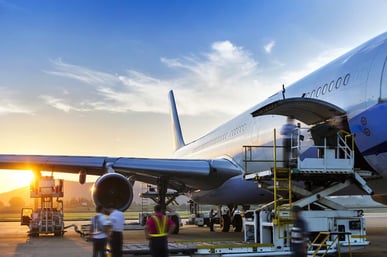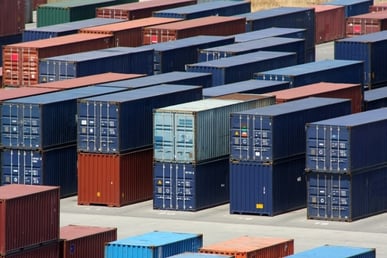Just when you think you have found the solution to an incredibly difficult problem, you find you have simply created issues elsewhere.
That is the case in ocean freight container shipping with new transshipment networks designed to mitigate the impact of diversions in the Red Sea only serving to create wider congestion at Mediterranean ports.
Ultra-large ships from the Far East are now offloading containers at western Mediterranean ports such as Barcelona, with smaller ships then transporting them to the final destinations at central and eastern Mediterranean ports. This means the larger ships can return immediately to the Far East rather than enter the Mediterranean Sea dead end created by the Suez Canal diversions.
Record transshipments in Barcelona
As a result, the port of Barcelona handled 63% more container transshipments in March 2024 compared to 12 months ago – up from 94,000 TEU to 154,000 TEU.
Looking at Q1, Barcelona handled a record high 446,000 TEU, which is an increase of 48% compared to Q1 2023 and the equivalent of an additional 144,000 TEU.
This surge in transshipments has also been seen at the other major Spanish ports of Valencia, Algeciras and Las Palmas.
Together with Barcelona, these are the top four container shipping ports in Spain, handling 85% of the nation’s total of 16.4m TEU in 2023 (8.4m of which was transshipped).
An additional 2.36m TEU was handled by the other 24 ports across Spain, of which only 0.43m TEU was transshipments (source: Puertos del Estado).

The recent increase in transshipments at Spain’s four largest ports follows a decline of 4.9% for the full year of 2023 compared to 2022, with Barcelona accounting for more than half of that deficit (234,000 TEU).
An increase in demand of this magnitude in a short space of time will inevitably lead to significant port disruption.
Port congestion is bad news for shippers
The increasing use of transshipments is designed to improve the service for shippers – however it is coming at a cost.
The trade from Singapore (Asia’s largest transshipment hub) to Barcelona is a good example.
Spot market freight rates jumped by 10% on this trade in the early days of May to reach USD 4 394 per FEU. This coincides with congestion at Barcelona port and a growing line of container ships waiting to berth.
On 7 May, the average waiting time to berth at Barcelona increased to 3.53 days due to increased cargo flow as well as lower productivity, IT issues and bad weather in late April/early May. This is an increase from 3.28 five days earlier. (source: K+N seaexplorer).
The trade lane from Singapore to Las Palmas tells a similar story. Spot rates hit a Red Sea crisis peak of USD 6 217 per FEU in mid-January but then fell back by 37% to USD 3 909 at the start of April.
However, increasing port congestion meant this softening market did not last and rates began to increase sharply again, up by 38% to reach USD 5 448 per FEU on 5 May.

Whereas Barcelona is third to Algeciras and Valencia in terms of total TEU and transshipment handlings, it has seen faster growth on both accounts in first three months in 2024.
In the Atlantic basin on Gran Canaria, 56% of the business in the container terminals of the port of Las Palmas is transshipment, this is second only to Algeciras in the West Mediterranean where 85% is transshipped.
| Port | Transshipment as share of total TEU - 2023 full year | Transshipment as share of total TEU - Q1 2024 |
| Algeciras | 84% | 85% |
| Las Palmas | 52% | 56% |
| Valencia | 49% | 51% |
| Barcelona | 40% | 47% |
Handling in three months, the same number of boxes handled last year in 4.5 months will obviously cause problems.
Is congestion likely to ease?
As long as Red Sea diversions remain in place and carriers attempt to mitigate increased sailing distances through transshipment networks then west Mediterranean ports will continue to feel the brunt.
There is also no suggestion that decreasing demand for ocean freight container shipping from the Far East to Mediterranean will help to ease congestion – quite the opposite.
Data for January and February 2024, reveals that container imports from the Far East into the Mediterranean hit record high levels.
Exports from China alone was up by 11.4% year-on-year into the Eastern Mediterranean and Black Sea while volumes into the Western Mediterranean Sea increased by 20.7%.
This increasing demand continued in March, with volumes into the Western Mediterranean Sea up by 4.0% from China and 5.7% from the wider Far East region.
However, demand did decline into the Eastern Mediterranean in March compared to 12 months ago, down by 6.5% from China and 3.3% from the wider Far East region. (source: Container Trades Statistics)
Schedule reliability at low levels
Even though schedule reliability from Singapore to Barcelona improved in March compared to February, an increase from 33.1% to 40.0% is no cause for celebration.
Two in every five ships arriving on time is not the level of service shippers will expect, however they may find a small amount of comfort in the fact March was the first time reliability has improved month-on-month since it stood at 66.6% in November 2023.
Wider implications of Mediterranean congestion
Increasing use of transshipment networks in the Mediterranean requires more ships for the feeder services and carriers may achieve this by removing ships from other trades, particularly those in North Europe.
If ships are redeployed in this way it could create a capacity squeeze on trades in North Europe while further compounding the congestion issue in the Mediterranean – and push up rates across them all.
No escape from the impact of a black swan event
Black swan events cause pain in supply chains and, while ocean freight networks have proven their immense resilience in recent years, there are always inescapable consequences.
These consequences often make their presence felt away from the immediate region where the black swan occurred – in the case of the Red Sea conflict we are seeing the ripples cast far and wide.
As well as congestion at Mediterranean ports we have also seen rates increase on Transpacific and Transatlantic trades which do not transit the Suez Canal.
This underlines the importance of using data to monitor individual trades and port-to-port services because each one will react differently and present different problems to overcome.
%201.png)






